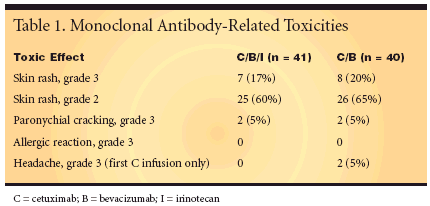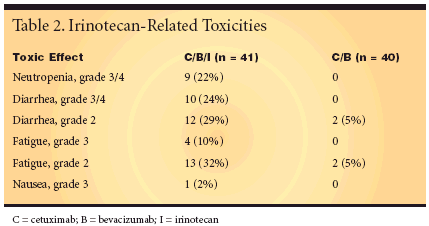Bevacizumab May Enhance Cetuximab/Irinotecan Efficacy in Refractory Colorectal Cancer
NEW YORK-“Bevacizumab(Avastin) appears to add to theefficacy of cetuximab (Erbitux) and
NEW YORK-"Bevacizumab(Avastin) appears to add to theefficacy of cetuximab (Erbitux) andcetuximab/irinotecan (Camptosar) inirinotecan-refractory bevacizumabnaivecolorectal cancer patients," whencompared with historic controls, accordingto Leonard B. Saltz, MD, ofMemorial Sloan-Kettering CancerCenter in New York. He reported on aphase II trial of the concurrent administrationof two monoclonal antibodies-cetuximab and bevacizumab-with or without irinotecan (abstract3508)."This is the first trial in which thesetwo antibodies were given to patientsat the same time," Dr. Saltz noted.Cetuximab targets the epidermalgrowth factor receptor (EGFR), whereasbevacizumab targets the vascularendothelial growth factor (VEGF).Naive to Both MonoclonalsAll patients in the phase II trial hadirinotecan-refractory disease and werenaive to both monoclonal antibodiesstudied. Patients were randomized toreceive one of the two following regimens:
- Cetuximab (400 mg/m2 loadingdose, then weekly at 250 mg/m2) plusbevacizumab (5 mg/kg every otherweek), and irinotecan (same dose andschedule as last received prior to thestudy)
- The same cetuximab and bevacizumabdosing schedules but withoutirinotecan.
Cetuximab was started on day 1,but for the first week only, bevacizumabwas started on day 2 "in order topermit assessment of these agents separately,"Dr. Saltz said.The trial was initially planned toaccrue 75 patients in each arm, butstatistics were recalculated for a lowernumber because of the widespreadcommercial availability of bevacizumaband "the scarcity of bevacizumab-naive patients," Dr. Saltz said.Data were reported for 81 patientsrandomized to the two arms: 41 in thearm with irinotecan and 40 in the armwithout irinotecan. "There was a slightimbalance in terms of older patientsin the irinotecan arm," Dr. Saltz said."Otherwise, there were no significantdifferences between the arms." Themedian age in the irinotecan groupwas 64 years (range, 43-86 years), andin the arm without irinotecan it was56 years (range, 24-80 years).
Predictable Toxicities
"Toxicities were as would be ex-pected from the individual agents,without clear evidence of synergisticeffect," Dr. Saltz said. The primarytoxicity related to the monoclonal antibodieswas skin rash (see Table 1)."We don't see a significant interactionbetween the arms as would be expected,"Dr. Saltz said. "We see a degree oftoxicity that is not outside the parameterswe might expect from cetuximabalone," he said.


"In terms of irinotecan-related toxicities,as would be expected, we seesubstantial increases in neutropenia,diarrhea, both grades 2 and 3/4, as wellas fatigue, with over 40% of patientshaving grade 2 or 3 fatigue when givenirinotecan, as compared with only 5%having grade 2 fatigue with the antibodiesalone" (see Table 2)."One of the concerns was whetherthe adverse-event profiles would amplifyeach other," Dr. Saltz noted. "Wedid see some evidence of those events,which could potentially be consideredrelatable to either bevacizumab orcetuximab. These are somewhat vaguein nature and certainly could also beattributed to the advanced disease ofthese patients." The adverse effects includedupper and lower gastrointestinalbleeding, rectal fistula, and onemyocardial infarction (which was ultimatelyfatal).
Usefulness of RegimenRemains Unknown
Partial responses occurred in 15patients (37%; 95% confidence interval[CI]: 22%-53%) in the irinotecanarm and 8 patients (20%; 95% CI: 9%-36%) in the cetuximab/bevacizumabonlyarm. Median time to progressionwas 7.9 months for patients receivingirinotecan and 5.6 months in thosenot receiving irinotecan."The usefulness of bevacizumabwith cetuximab in patients with priorbevacizumab exposure remains unknown.Studies to address this questionare in development," Dr. Saltzsaid. "But I would emphasize that atthis point, the applicability of thesedata to practice today is highly questionable,since patients who are bevacizumab-naive getting to this point intheir therapy are quite rare," Dr. Saltzadded."Perhaps most importantly, thestudy served as the safety pilot for thecurrent CALGB/SWOG study, whichwill be opening momentarily," Dr.Saltz said. The Cancer and LeukemiaGroup B/Southwestern OncologyGroup study gives investigators thechoice of using either FOLFOX (fluorouracil,leucovorin, oxaliplatin [Eloxatin])or FOLFIRI (fluorouracil, leucovorin,irinotecan) and thenrandomizing patients also to receivecetuximab, bevacizumab, or the combinationof the two monoclonal antibodies.
Inhibitory Strategies
The need for additional studies wassupported by Neal J. Meropol, MD, ofFox Chase Cancer Center in Philadelphia,who served as a discussant forthis ASCO session. "While the patientnumbers are small and this should notlead to a change in practice, this pilotstudy provides sufficient clinical validationto warrant phase III testing ofthis concept," he said."The study by Saltz and colleagueslends credence to the notion that approachinga cancer as a system of interrelatedand interdependent pathwayscan yield clinical fruit. It is alsoclear that colorectal cancers are a heterogeneousgroup of diseases characterizedby various pathway addictionsand redundancies," Dr. Meropol continued."Ultimately, it is hoped thatdescribing the networks of individualtumors will lead to individualized selectionof inhibitory strategies."As potential examples of suchstrategies, Dr. Meropol mentioned"combinations of receptor inhibitorsor EGFR inhibitors in combinationwith inhibitors of downstream pathways."
Newsletter
Stay up to date on recent advances in the multidisciplinary approach to cancer.